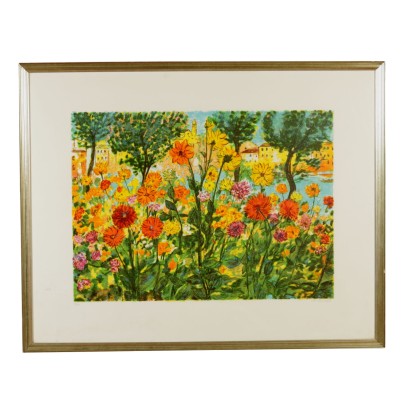Silk-screen Printing by Michele Cascella - Dahlias in Portofino, 1988
Features
Dahlias in Portofino, 1988
Artist: Michele Cascella (1892-1989)
Artwork title: Dalie a Portofino
Age: 20th Century / 1901 - 2000
Subject: Landscape
Artistic technique: Multiple Print
Technical specification: Screen Printing
Description : Dalie a Portofino
A silk-screen printing by Michele Cascella (1892-1989), signed in the lower right corner. Number 52/150 in the lower left corner. Accompanied by a provenance certification by the Selection Art Gallery of Turin. It is presented in frame. 1988.
Frame Size (cm):
Height: 100
Width: 126
Depth: 5
Artwork dimensions (cm):
Height: 94
Width: 120
With certificate of authenticity
Additional Information
Artist: Michele Cascella (1892-1989)
Michele Cascella (Ortona, 7 September 1892 - Milan, 31 August 1989) was an Italian twilight painter and landscape painter. After having carried out his first artistic activities under the guidance of his father Basilio, in 1907, together with his brother Tommaso, he held his first personal exhibition in the rooms of the Famiglia Artistica of Milan. In 1909, again with his brother Tommaso Cascella, he set up an exhibition in the Druet Gallery in Paris, participating in the Salon d'Automne in the same year. In 1911 he organized an exhibition of pastel drawings in the Ridotto of the National Theater in Rome. Between 1914 and 1915 he collaborated on La Grande Illustration published by his father Basilio with drawings and graphic illustrations, exhibiting in 1917 at the Press Association Salon and in the Central Art Gallery in Milan. Participates in the First World War. In Rome, in 1919, he held a personal exhibition at the Bragaglia Gallery and on that occasion met Carlo Carrà who then allowed the exhibition to be transferred to the Lidel Gallery in Milan. In 1920 he settled permanently in Milan where he enthusiastically frequented the poet Clemente Rebora, from whom he confessed to having drawn inspiration for the creation of some of his works. From 1928 to 1932 he traveled between Italy and Paris, where in 1937 he was awarded the gold medal at the International Exhibition. In 1938 he designed the sets for the opera "Margherita da Cortona" performed at the Teatro alla Scala. From 1928 to 1942 he was present at all editions of the Venice Art Biennale. Since 1938 he has lived in Portofino, which is a source of inspiration and therefore a privileged subject of his late works. Between 1937 and 1938 he created a large mosaic in the new Messina Marittima station, depicting Mussolini who, on a visit to Palermo, "elevated Sicily to the burden of being the Center of the Empire". After the Second World War his exhibitions abroad became more frequent: Paris (in the fifties and sixties) but also South America (especially Buenos Aires and Montevideo) and the United States. And it is precisely in the USA, in California, that he will settle for long periods of time, alternating periods of stay in Italy (he resided for some years in the countryside near Colle Val d'Elsa) and in Europe. His production focuses more on Abruzzo landscapes, flowers, poppies and wheat fields, on glimpses of Portofino, subjects that allow him to express his talent as a colorist. Since 1945 Michele Cascella's painting has been affected by that Neo-Cubism conditioned by the recovery of Cézanne; but his way of painting has preserved an autonomy from the avant-gardes for his eighty years of activity, maintaining a unique style. Cascella passed away in Milan in 1989 after dedicating his life to painting and experimenting with different graphic techniques: from lithography to etching, from screen printing to chromolithography.
Age: 20th Century / 1901 - 2000
20th Century / 1901 - 2000
Subject: Landscape
Artistic technique: Multiple Print
Technical specification: Screen Printing

























